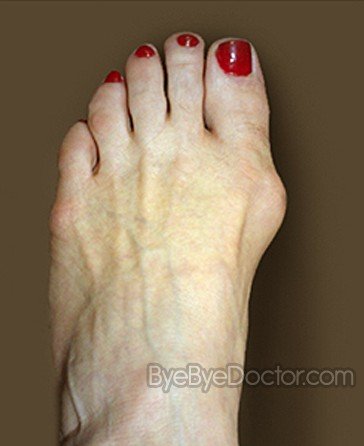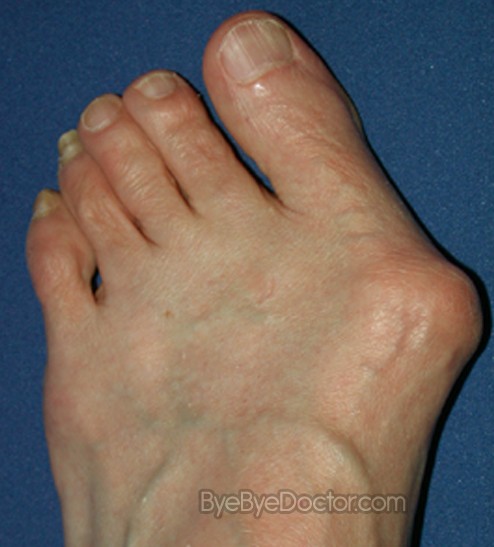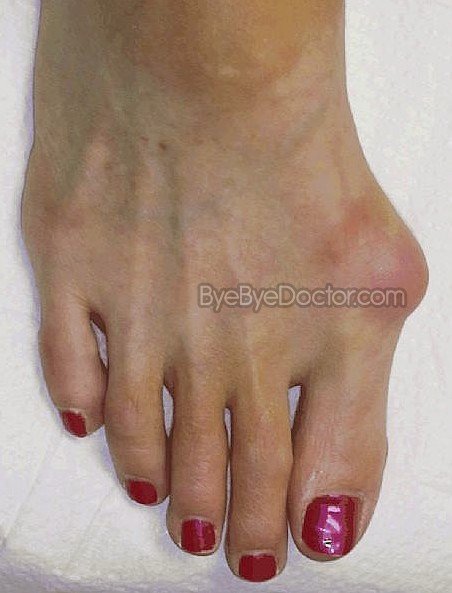What is a Bunion?
It is an atypical, bony bump which develops at the base on the joint of the big toe. This joint becomes distended, which forces the toe to push into the other toes. This pushing places pressure on the big toe joint, assertively forcing it outward beyond the standard outline of the foot, and causes pain.
Bunions may develop for numerous reasons with a common reason being wearing shoes which are too tight. The bunions also develop because of a genetic structural flaw, stress on the foot or some medical problems for example arthritis.
Frequently, the treatment for bunions involves steps which are very conservative, such as changing shoes, wearing inserts inside the shoes, or padding the bunion. Cases of severe bunions may need surgery.
Bunion Symptoms
Bunions may not create any symptoms. But if you do have any symptoms, they can include:
- A protruding bump on the outside of the base of the large toe
- Swelling, soreness or redness around the big toe joint
- Skin at the base of the big toe which thickens
- Irritation over the bunion
- Where the 1st and 2nd toes overlap there may develop calluses or corns
- Intermittent or persistent pain
- Big toe has restricted movement
The pain of a bunion may range from very mild to quite severe, and can often make it hard to walk in normal shoes. The deeper tissue and the skin around the bunion can become inflamed and swollen.
The other toes may be affected by a bunion due to pressure from the big toe pushing inwardly towards them. The toenails can begin to grow into the side of the nail bed. The smaller toes also may develop bent over or claw-like which is known as hammertoes.
Bunions as well as their symptoms grow gradually. They are often confused with the symptoms of gout, but the pain of gout normally comes on suddenly and may be more severe than the pain of bunions. The pain of gout and its swelling tends to occur in stages, while the pain of bunions is much more constant. Different from a bunion, gout normally does not cause deformity of the joint.
Bunions often do not require any medical treatment but an individual should see their physician or a physician specializing in the management of disorders of the feet, if they have any of the following:
- A visible bump on the big toe joint
- Stubborn big toe or foot pain
- Movement which is decreased in the big toe or foot
- Difficulty in finding shoes which fit properly
Bunion Causes
Bunions normally develop when the balance of exerted forces on the joints as well as the tendons of the feet are interrupted. This may lead to some unsteadiness in the joint of the big toe and this causes a deformity. Bunions grow over time because of the atypical pressure or motion on the joint of the big toe. Bunions as well can develop on the joint of the little toe which is known as a bunionette.
Causes of bunions include:
- Inherited foot type
- Ill-fitting or high-heeled shoes
- Congenital deformities
- Foot injuries
Bunions can also be linked with a number of types of arthritis, including degenerative as well as inflammatory forms, causing the cartilage which is protective and covers the big toe joint to deteriorate. Any occupation which puts any excessive stress on the feet or which causes the individual to wear pointed shoes can also be a cause. For instance, cowboys as well as dancers are very prone to the developing of bunions.
Other facts which lead to a bunion include:
- Ligaments in the foot which are loose
- Prior foot injury
- Amputation or removal of the second toe – this makes it easier for the big toe to drift towards the other toes.
There are factors which can increase the risk of bunions:
- High heels – which forces the toes into the front of the shoes and crowds the toes
- Being female – Women are much more likely to get bunions.
- Have atypical rolling inwards of the foot when walking
- Have Rheumatoid arthritis which causes deformity and swelling around the big toe joint
- Having a hobby or job which places considerable stress on the feet
- Have low arches or flatfeet
- Ill-fitting shoes – which are often too tight, too narrow or too pointed causing susceptibility to bunions.
- Heredity – genetic structural foot defect which has the tendency to cause bunions to develop
- Arthritis – because of the pain it can change the way one walks and causes susceptibility to bunions
Bunions may occur at any time and they do not always cause problems. They are permanent unless there is surgery to correct the defect. If the bursa or cushioning sac of fluid over the joints which are affected become inflamed (known as bursitis), the bunion can become extremely painful and can interfere with usual activities. Bunions can also be more painful and larger which makes nonsurgical treatment less effective.
http://www.Symptoms-Causes-treatment.blogspot.com detect diseases at an early stage symptoms, and find out the causes and treatments best suited.
Bunion Treatment
The options for treatment will depend on the severity of bunion as well as the amount of pain it can cause. Treatment which is early is best to decreasing any risk of joint deformities developing.
Conservative treatments are nonsurgical options which can relive the pain as well as the pressure of a bunion and they include:
Shoes changing
Wear shoes which are comfortable, roomy and have sufficient space for the toes.
Taping and padding
By taping or padding the feet in a typical position the stress on the bunion can be reduced and this also alleviates the pain.
Medications
For control of pain of bunions, it is suggested that individuals use acetaminophen (Tylenol), non-steroidal anti-inflammatory medications such as ibuprofen (Motrin, Advil) or naproxen (Aleve). All of these relieve pain and reduce inflammation. Cortisone injections can also be useful.
Shoe inserts
Orthotics or padded shoe inserts may help with any control of abnormal movements of the feet, reducing symptoms and stopping bunions from getting worse. Arch supports which are over-the-counter, can offer relief for some individuals, while other individuals may require orthotics which are prescriptions written by physicians.
Surgical options can be used if conservative options do not offer symptom relief. There are numerous surgical procedures which can be performed for bunions and no specific surgery is indicated as best for every problem. The picking the best procedure to ensure correction with no recurrence, it is important to know what is causing the bunion for any specific individual. Most of the surgical procedures include a bunionectomy that involves:
- Removing the tissue which is swollen from around the joint of the big toe
- Realignment of the metatarsal bone in order to reduce angular deformity
- Straightening the big toe by removing parts of the bone
- Joining the bones of the affected joint permanently
After surgery it is possible to walk on the foot immediately after some bunion procedures but not with others. Others may require full recovery which can take up to 8 weeks or longer. Proper shoes need to be worn after recovery in order to prevent a recurrence.
Surgery is not recommended unless the bunion causes repeated pain or restricts daily activities. A bunionectomy – just the same as other types of surgery – is not without its risk. In addition, there may still be pain or a new bunion may develop in the big toe joint after surgery. It is important to consider conservative treatment prior to having a bunionectomy.
Surgery is not a recommendation if an individual:
- Have not tried non-surgical treatment
- Have other problems with health which makes surgery more dangerous. These include diabetes, neuromuscular disorders, and circulatory problems.
- Have unrealistic expectations on the results of surgery
Bunion Home Remedies
Tips which can provide relief from bunions include:
- Applying a bunion pad with no medication around the bony bump
- Shoes need to have a deep and wide toe box
- If a bunion develops inflammation or pain, apply ice 2 to 3 times daily to help reduce swelling
- Avoiding shoes with heels higher than 2 ¼ inches or 5.7 centimeters
- See the doctor if pain perseveres
Bunion Pictures


 Moderate Bunion
Moderate Bunion

 Severe Bunion pictures
Severe Bunion pictures